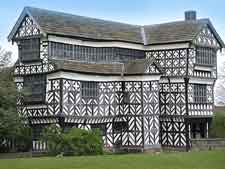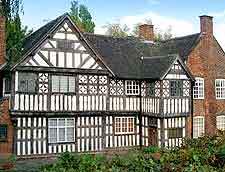Stoke on Trent History Facts and Timeline
(Stoke on Trent, Staffordshire, England)

The city of Stoke on Trent didn't come into being until March 1910, with the Federation of the Six Towns. The six towns in question were Burslem, Fenton, Hanley, Longton, Stoke and Tunstall.
History shows, however, that there have been settlements scattered throughout the Stoke on Trent area for thousands of years. The first records of Hanley's existence appeared in 1227. Known then as Hanlih, it was nothing more than a small village. Evidence of coal mining and iron working in Tunstall also date back to the 13th century. Throughout the Middle Ages, these settlements remained little more than villages.
History From the 17th to 19th Centuries
Stoke on Trent's pottery industry dates back to the mid-17th century, when a small community of farmer-potters was established. They made pots for butter made in Burslem. Hence, Burslem is regarded by many as the 'mother of the potteries'. Potters started to set up small factories in nearby Hanley, Stoke and Tunstall, as well as Fenton and Longton, and by 1740, a quite substantial industry had grown up here.
As time went on, the potters began to use less local clay because it fired red. Instead, they imported white clay from south-western England. Two of the best-known pottery companies in Stoke on Trent were those set up by Josiah Wedgwood in 1759 and Josiah Spode in 1767. Later ones included the likes of Minton, Aynsley and Doulton.

In 1848, a railway station was built in Stoke on Trent and a new era in history dawned. This rendered the Trent and Mersey Canal, built 60 years earlier, obsolete. Clay could be imported much more easily by rail. By this time, the villages of the potteries had grown into sizeable towns, with Burslem the largest.
As its working population grew, so too did the popularity of the sport of football. The Stoke City Football Club was established in the 1860s and went on to become one of the founding 12 teams of the Football League that first kicked off in September 1888.
Modern Times
A federation had been proposed as early as 1888. However, it wasn't until 1910 that the six towns were officially amalgamated and Hanley was named as its centre. In 1925, a federated Stoke on Trent finally achieved city status.
Today, Stoke on Trent is still a centre for the ceramics industry in Britain, famous for its tableware, tiles and sanitary ware. In 1938, half of its working population was employed in pottery factories. Even as late as 1954, the industry was buoyant enough to warrant the Wedgwood company opening its own railway station. Although the numbers employed in the industry have since declined, it still remains an important part of the city's life. Indeed, in the 1980s, a new ceramics company, Emma Bridgewater, moved to the city.
The city was also known as a centre for mining. In 1947, around 20,000 people were employed in collieries here. Today, all the mines are closed. The site of the Chatterley Whitfield Colliery has been transformed into a local nature reserve.
Famous sons of Stoke on Trent include Arnold Bennett, who wrote a fictional account of a northern British city that was an amalgamation of five towns. It wasn't long before the unhappy folk of Fenton worked out that Bennett, a Burslem man, had left them out. The acclaimed footballer Sir Stanley Matthews was also a local lad, beginning his professional career here in 1931.
 The city of Stoke on Trent didn't come into being until March 1910, with the Federation of the Six Towns. The six towns in question were Burslem, Fenton, Hanley, Longton, Stoke and Tunstall.
The city of Stoke on Trent didn't come into being until March 1910, with the Federation of the Six Towns. The six towns in question were Burslem, Fenton, Hanley, Longton, Stoke and Tunstall. In 1848, a railway station was built in Stoke on Trent and a new era in history dawned. This rendered the Trent and Mersey Canal, built 60 years earlier, obsolete. Clay could be imported much more easily by rail. By this time, the villages of the potteries had grown into sizeable towns, with Burslem the largest.
In 1848, a railway station was built in Stoke on Trent and a new era in history dawned. This rendered the Trent and Mersey Canal, built 60 years earlier, obsolete. Clay could be imported much more easily by rail. By this time, the villages of the potteries had grown into sizeable towns, with Burslem the largest.